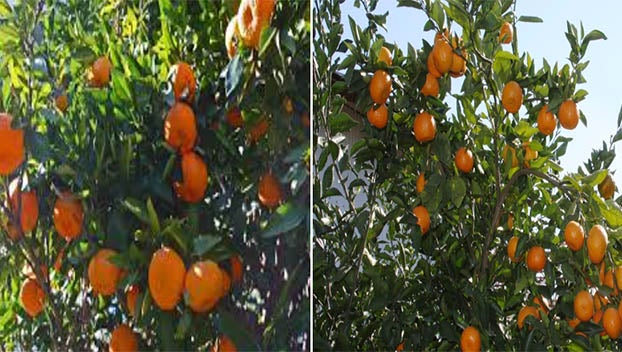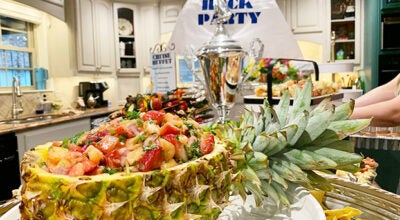MASTER GARDENER — Time to harvest Satsumas; know these facts
Published 12:04 am Thursday, November 3, 2022

- Both satsuma trees have been thinned and are loaded with fruit ready for harvest. Arctic Frost (left) and Orange Frost (right) are cold hardy to 20 degrees F once well established. (Images courtesy Agrilife Today)
|
Getting your Trinity Audio player ready...
|
While driving around different communities in SETX, you’ve probably noticed (I certainly have) Satsuma trees are displaying bright orange-yellow fruits that are ripening.
Did you know after cycling through numerous names since its inception, the name of Orange was finally chosen due to the native orange groves that attracted the attention of boatmen navigating the Sabine River?
Of course, the original orange groves are long gone, lost to history due to our ever-changing environment, natural and otherwise.
There is one significant detail that has not been lost to history, and that is our love for growing citrus trees: Satsumas, tangerines, clementine’s, Halos, Cuties and other types of mandarin oranges (Citrus unshiu). The fruit is flat on the bottom, not round like most orange varieties. Being the sweetest citrus, they are also extremely easy to peel.
Satsumas are the most cold-tolerant of sweet citrus. Texas A&M AgriLife Extension Services began field trials in 1994 to determine the most cold-tolerant citrus. Once the trails were completed, two satsuma varies performed well, ‘Miho’ and ‘Seto.’ Both were added to the Texas Superstar program in 2010.
With continued testing, two other varieties were developed — ‘Orange Frost’ and ‘Arctic Frost’ were added to the Texas Superstar program in 2014 and 2015, respectfully. Each produces quality fruit with few seeds, and both are extremely cold hardy.
Satsumas require winter protection for the first three years until established. They grow equally well if planted in the ground or in a large container. For the best winter protection, build a temporary frame using PVC pipe to “house” the tree, covering the PVC pipe with clear polyethylene. Until established, they should be protected if temperatures are expected to fall to 25°F or below. Once established (3 years growth), winter protection is no longer required unless temperatures fall below 20°F. At the onset of cold weather, trees planted in the ground should have a bank of mulch /soil up and around the trunk of the tree. This will help protect the trunk if the main trunk dies back during severe cold weather. If the tree is a grafted tree, such as ‘Miho’, ‘Owari’, ‘XIE’ or ‘Miyagawa’, the bank of mulch/soil must extend above the graft union to protect the scion. ‘Orange’ and ‘Arctic’ Frost satsumas are typically grown from cuttings or seeds and on their own root stock.
The tree can also be grown in a large pot, at minimum 24 inches wide by 24 inches tall or a large nursery pot (25 gallon). The tree must be repotted every few years since they will fill the containers quickly.
Remove the tree from the pot, trimming the roots around the perimeter and bottom of the root ball. To remove old potting soil, use a blast of water from a garden hose. Repot using good quality soil in the bottom and around the sides, utilizing the same pot.
For trees in the ground, provide a nitrogen fertilizer each spring. If you notice a yellowing of the newer leaves (chlorosis), add iron following package directions. Container planted trees required a slow-release fertilizer, applied in spring before new growth appears. A supplemental water-soluble fertilizer can be applied every 2-3 weeks to support the tree and the fruit crop.
Now for the difficult part, once the fruit is set in spring, it must be thinned. Doing this is tough because all gardeners want as many satsumas as possible, but this is necessary to maintain the trees’ overall health.
Thinning fruit-one fruit for every 12 inches of limb, removes weight stress generated from too much fruit growing on each limb. I have personally experienced my trees loaded down so heavily the limbs break, which severely damages the tree and invites disease.
The blooms in the spring are intensely fragrant and citrus trees are known hosts for the Giant Swallowtail Butterfly. The female butterfly seeks out the leaves to lay her eggs. The caterpillars look like bird droppings making them unattractive to predators.
It is very important to purchase citrus trees locally, from local garden centers or nurseries within SETX. By purchasing locally, we are helping keep deadly citrus diseases, Citrus Canker and Citrus Greening from getting established in our counties.
The Texas Department of Agriculture mandates strict guidelines for growing citrus trees to help keep these diseases outside of our areas. Further, it is against the law to bring citrus, in any form, into Texas, or our area from quarantined counties west of us. For more information on these diseases, go to agrilifetoday.tamu.edu.
So, now my fellow gardeners, let’s go out and grow ourselves a greener and more sustainable world, one Satsuma tree at a time.
John Green is a Certified Texas Master Gardener. If you have gardening questions or need more information, contact the Orange County Master Gardeners Helpline at 409-882-7010 or visit txmg.org/orange, Orange County Texas Master Gardeners Association on Facebook or email extension@co.orange.tx.us.





